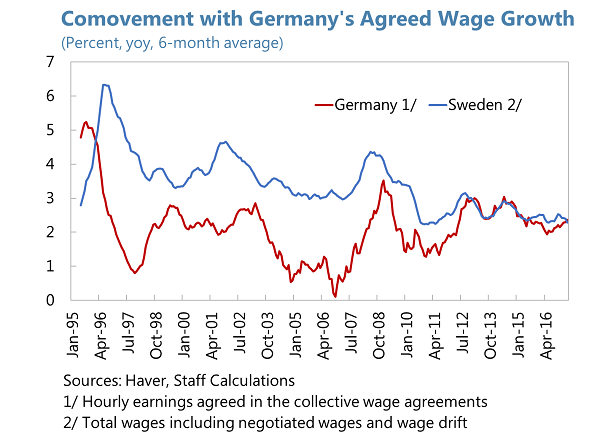I sina slutsatser från den pågående granskningen av den svenska ekonomin drar IMFs granskare liknande slutsatser om lönebildningen och märkessättningen som AER gjort tidigare. Gruppen uttrycker oro för att lönebildningen inte i tillräckligt hög grad bidrar till att omallokera arbetskraft till de sektorer som har störst arbetskraftsbrist. Dessa innefattar byggsektor och IT liksom utbildning, sjukvård och andra “social services”. Man rekommenderar arbetsmarknadens parter att försöka komma överens om sätt att bättre anpassa löneutvecklingen till den svenska arbetsmarknadssituationen både på makro- och sektorsnivå. Enligt analysen har de svenska lönerna i alltför hög grad följt utvecklingen i Tyskland i stället för att styras av arbetsmarknadsläget i Sverige.
Gruppen betonar vikten av att uppnå en bred konsensus om alla förändringar. IMF-delegationen skriver följande i sitt avslutande uttalande (som går att läsa här):

6. Sweden’s wage formation system has long functioned well, but current nominal wage rises are out of sync with domestic fundamentals. For many years the wage setting process led by the industrial sector generated an enviable combination of solid real wage growth, high employment, and low labor disputes. Yet this system has increasingly anchored Swedish nominal wage rises on those in Germany. But wage growth in the 2.0‑2.5 percent range is too low relative to Swedish productivity trends and inflation targets, which would indicate rises of about 1 percentage point more. Higher nominal wage rises may not add significantly to real wage growth owing to higher inflation and a weaker trend in the krona than otherwise, but they would relieve pressure on monetary policy to prolong low interest rates.
7. Moving labor to areas with increasing needs is essential in coming years . Besides the construction and IT sectors, the areas with greatest labor shortages include education, health care, and other social services. The outlook for rises in both the young and elderly populations imply that such shortages will worsen, requiring these sectors to attract employees with the right skills that are currently working elsewhere. However, the wage setting system has great difficulty allowing relative wages to incentivize the reallocation of labor to where it is most needed.
8. The social partners should work to build consensus on making wages more responsive to Swedish conditions at both the macroeconomic and sectoral level. A range of approaches could be considered while preserving collective bargaining and protecting high employment. But the bottom line should be wage rises that are anchored on trends in Sweden’s labor productivity and medium-term inflation expectations, and which are sustainable in relation to business sector profitability, as analyzed in the annual wage formation reports of the National Institute of Economic Research. A combination of greater scope for sectoral wage differences and firm‑level flexibility would help to better meet the changing labor needs ahead. Discussions with the social partners indicate that broad consensus on a new approach would be key to ensuring that it functions well in practice.
9. New initiatives to boost employment of the low-skilled and migrants are emerging; these will be most effective as a coherent package of programs that meet the needs of different groups. The foreign-born now account for over half of unemployment and unemployment rates are also high for the low-skilled, such that further unemployment reductions must come from these groups. Alongside others seeking to address this challenge, LO (the Swedish Trade Union Confederation ) has put forward a Job and Education Initiative to facilitate labor market entry by adults who lack sufficient knowledge and skills. Temporarily lower wage costs for these employees would encourage employer participation, while the government would need to provide well‑matched educational opportunities and student aid to ensure a reasonable standard of living. This initiative would be complemented by approaches that address the needs of other groups, with younger working age persons more likely to benefit from a greater emphasis on education, while older persons may need more prolonged wage subsidies and work that matches their capacities.
